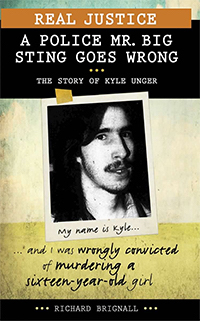| ________________
CM . . . . Volume XXI Number 38 . . . . June 5, 2015
excerpt:
Reluctant readers are the intended audience for the "Real Justice" series that explores mostly Canadian instances of wrongful convictions. The text of this latest volume is easy-to-read and informative as it explains details about the judicial system and methods of policing. Kyle Unger's story may not be well known outside of Manitoba, but middle school and high school students reading this book will quickly recognize many of the people in this story: the high school dropout who is somewhat a loner and not one of the popular kids in school, the popular and friendly teenage girl who is ready for a boyfriend, and possibly the police investigators with tunnel vision who are determined to secure a conviction once they decide that someone is guilty of a crime. Brigitte Grenier was 16 and just finishing grade 11 when she was sexually assaulted and brutally murdered in late June 1990 while attending a music festival near the town of Roseisle, MB. The prime suspect, Tim Houlahan, was a 17-seventeen year old who could not be named because he was shielded by the Young Offenders Act. When he gave an early statement to police, he claimed that following consensual sex with the victim, she disappeared but another man appeared and assaulted him. In recreating a sequence of events, Brignall, who notes that the RCMP asked Houlahan about two other young men, speculates that this gave Houlahan the idea to try to finger one of them, Kyle Unger, as the murderer when he was arrested and made a second statement to the police. Soon, Unger was also arrested, but, because he was over 18, his name was the only one made public at that time, and soon he was convicted in the minds of many residents eager to see a murderer pay the price for the horrific crime. At the preliminary hearing, the Crown Attorney decided that there was not sufficient evidence against Unger to convict him; his charges were stayed but could be reinstated if new evidence made conviction more likely. Forensic sciences at this time were not as advanced as they are today. The only piece of hard evidence linking Unger to the victim was a strand of hair from the victim's sweatshirt that an expert in forensic microscopy later testified was consistent with Unger's hair samples. Most of the physical evidence pointed to Houlahan. The police were determined to get more evidence on Unger, especially after one inmate who had been in custody with Unger in 1990 told police that Unger had admitted to getting away with murder. This was the final encouragement that the RCMP needed to implement a Mr. Big sting. Unger was living and working at a hobby farm when he was befriended by two undercover RCMP investigators who pretended to be part of a criminal organization. The lure of easy money and the chance to be part of the organization were too much for Unger. He told them what they wanted to hear in order to impress them and gain a position in the organization. After initially denying murdering Grenier, Unger confessed to the murder, but many of the details that he invented were inaccurate. Soon he was re-arrested for murder and sent to trial with co-accused Houlahan in early 1992. Unger took the stand and recanted his confession. Both men were found guilty. Houlahan successfully appealed the verdict and was released on bail pending a new trial. He committed suicide before the retrial. Unger was unsuccessful in his appeal for a retrial. In 2003, DNA analysis proved that microscopic comparison of hair samples that were conducted in the previous decade and a half could be wrong and the Manitoba government established a review commission that looked at homicide cases that had relied on forensic microscopy as part of the evidence. Unger's case was one of two that was deemed worthy of reconsideration. DNA testing proved that the hair used as evidence against Unger was not his. Furthermore, the jailhouse informant's testimony had been found false. Unger was released on bail in November 2005. It took four more years before the federal justice minister overturned Unger's 1992 conviction. Manitoba officials decided that new findings including the fact that the crown and police had suppressed evidence in the case entitled Unger to an acquittal. This was the first time that someone wrongfully convicted of murder in Canada was acquitted rather than being retried or having charges stayed. Unger was fortunate that his parents supported him throughout his trials and imprisonment. The fact that he gave a false confession of guilt to undercover investigators was used as an argument by Manitoba officials to deny financial compensation for Unger's wrongful conviction. To date, he has been unsuccessful in seeking financial recompense. Sadly, the family of the murder victim continues to believe in Unger's guilt and believe that no one will ever be held responsible for Grenier's death. As for the use of the Mr. Big sting, Brignall notes that the Supreme Court of Canada recently introduced new standards for trial judges to consider when this form of investigation is employed. The confession must be proven to be reliable, and the judge must examine the police conduct during the investigation. Hopefully, this will weed out false confessions in the future. The book includes a timeline, a brief glossary focussing upon legal terms, a brief bibliography that includes video, radio and textual resources (complete with urls) and a serviceable index. Six pages of photographs, including contemporary newspaper images from the Winnipeg Sun, are all appropriate. Recommended. Val Ken Lem is a collections librarian at Ryerson University in Toronto, ON. Copyright © the Manitoba Library Association. Reproduction for personal use is permitted only if this copyright notice is maintained. Any other reproduction is prohibited without permission.
Next Review |
Table of Contents for This Issue
- June 5, 2015. |
